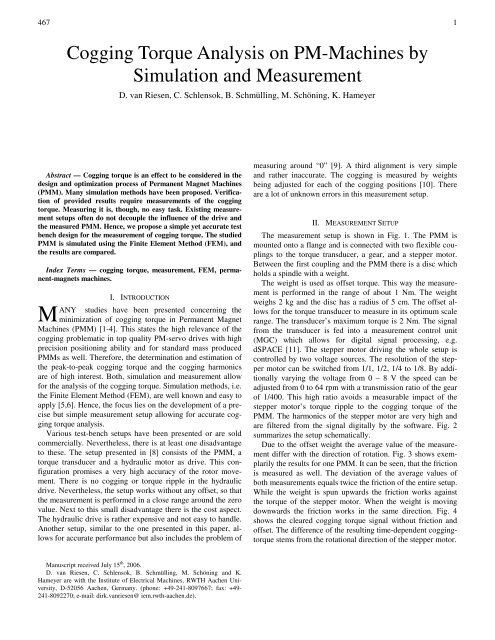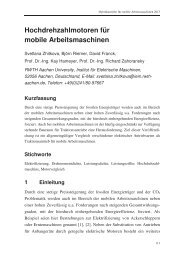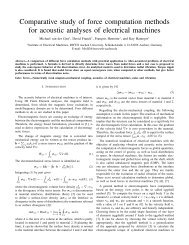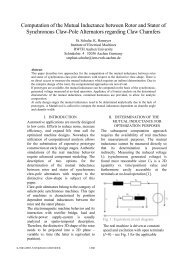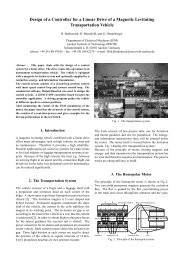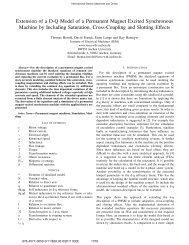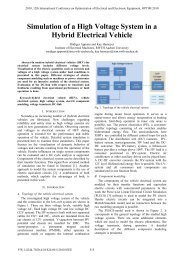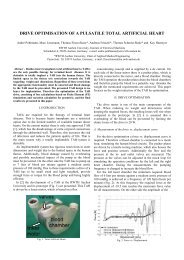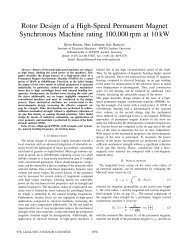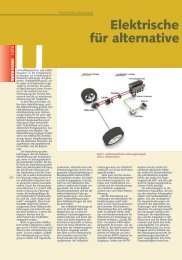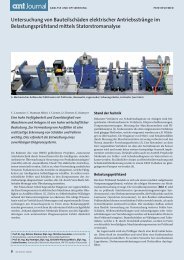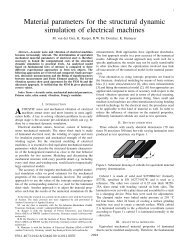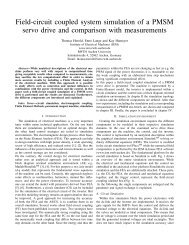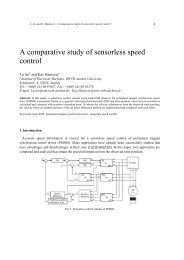Cogging Torque Analysis on PM-Machines by Simulation and ...
Cogging Torque Analysis on PM-Machines by Simulation and ...
Cogging Torque Analysis on PM-Machines by Simulation and ...
You also want an ePaper? Increase the reach of your titles
YUMPU automatically turns print PDFs into web optimized ePapers that Google loves.
467<br />
Abstract — <str<strong>on</strong>g>Cogging</str<strong>on</strong>g> torque is an effect to be c<strong>on</strong>sidered in the<br />
design <strong>and</strong> optimizati<strong>on</strong> process of Permanent Magnet <strong>Machines</strong><br />
(<strong>PM</strong>M). Many simulati<strong>on</strong> methods have been proposed. Verificati<strong>on</strong><br />
of provided results require measurements of the cogging<br />
torque. Measuring it is, though, no easy task. Existing measurement<br />
setups often do not decouple the influence of the drive <strong>and</strong><br />
the measured <strong>PM</strong>M. Hence, we propose a simple yet accurate test<br />
bench design for the measurement of cogging torque. The studied<br />
<strong>PM</strong>M is simulated using the Finite Element Method (FEM), <strong>and</strong><br />
the results are compared.<br />
Index Terms — cogging torque, measurement, FEM, permanent-magnets<br />
machines.<br />
M<br />
<str<strong>on</strong>g>Cogging</str<strong>on</strong>g> <str<strong>on</strong>g>Torque</str<strong>on</strong>g> <str<strong>on</strong>g>Analysis</str<strong>on</strong>g> <strong>on</strong> <strong>PM</strong>-<strong>Machines</strong> <strong>by</strong><br />
Simulati<strong>on</strong> <strong>and</strong> Measurement<br />
D. van Riesen, C. Schlensok, B. Schmülling, M. Schöning, K. Hameyer<br />
I. INTRODUCTION<br />
ANY studies have been presented c<strong>on</strong>cerning the<br />
minimizati<strong>on</strong> of cogging torque in Permanent Magnet<br />
<strong>Machines</strong> (<strong>PM</strong>M) [1-4]. This states the high relevance of the<br />
cogging problematic in top quality <strong>PM</strong>-servo drives with high<br />
precisi<strong>on</strong> positi<strong>on</strong>ing ability <strong>and</strong> for st<strong>and</strong>ard mass produced<br />
<strong>PM</strong>Ms as well. Therefore, the determinati<strong>on</strong> <strong>and</strong> estimati<strong>on</strong> of<br />
the peak-to-peak cogging torque <strong>and</strong> the cogging harm<strong>on</strong>ics<br />
are of high interest. Both, simulati<strong>on</strong> <strong>and</strong> measurement allow<br />
for the analysis of the cogging torque. Simulati<strong>on</strong> methods, i.e.<br />
the Finite Element Method (FEM), are well known <strong>and</strong> easy to<br />
apply [5,6]. Hence, the focus lies <strong>on</strong> the development of a precise<br />
but simple measurement setup allowing for accurate cogging<br />
torque analysis.<br />
Various test-bench setups have been presented or are sold<br />
commercially. Nevertheless, there is at least <strong>on</strong>e disadvantage<br />
to these. The setup presented in [8] c<strong>on</strong>sists of the <strong>PM</strong>M, a<br />
torque transducer <strong>and</strong> a hydraulic motor as drive. This c<strong>on</strong>figurati<strong>on</strong><br />
promises a very high accuracy of the rotor movement.<br />
There is no cogging or torque ripple in the hydraulic<br />
drive. Nevertheless, the setup works without any offset, so that<br />
the measurement is performed in a close range around the zero<br />
value. Next to this small disadvantage there is the cost aspect.<br />
The hydraulic drive is rather expensive <strong>and</strong> not easy to h<strong>and</strong>le.<br />
Another setup, similar to the <strong>on</strong>e presented in this paper, allows<br />
for accurate performance but also includes the problem of<br />
Manuscript received July 15 th , 2006.<br />
D. van Riesen, C. Schlensok, B. Schmülling, M. Schöning <strong>and</strong> K.<br />
Hameyer are with the Institute of Electrical <strong>Machines</strong>, RWTH Aachen University,<br />
D-52056 Aachen, Germany. (ph<strong>on</strong>e: +49-241-8097667; fax: +49-<br />
241-8092270; e-mail: dirk.vanriesen@ iem.rwth-aachen.de).<br />
measuring around “0” [9]. A third alignment is very simple<br />
<strong>and</strong> rather inaccurate. The cogging is measured <strong>by</strong> weights<br />
being adjusted for each of the cogging positi<strong>on</strong>s [10]. There<br />
are a lot of unknown errors in this measurement setup.<br />
II. MEASUREMENT SETUP<br />
The measurement setup is shown in Fig. 1. The <strong>PM</strong>M is<br />
mounted <strong>on</strong>to a flange <strong>and</strong> is c<strong>on</strong>nected with two flexible couplings<br />
to the torque transducer, a gear, <strong>and</strong> a stepper motor.<br />
Between the first coupling <strong>and</strong> the <strong>PM</strong>M there is a disc which<br />
holds a spindle with a weight.<br />
The weight is used as offset torque. This way the measurement<br />
is performed in the range of about 1 Nm. The weight<br />
weighs 2 kg <strong>and</strong> the disc has a radius of 5 cm. The offset allows<br />
for the torque transducer to measure in its optimum scale<br />
range. The transducer’s maximum torque is 2 Nm. The signal<br />
from the transducer is fed into a measurement c<strong>on</strong>trol unit<br />
(MGC) which allows for digital signal processing, e.g.<br />
dSPACE [11]. The stepper motor driving the whole setup is<br />
c<strong>on</strong>trolled <strong>by</strong> two voltage sources. The resoluti<strong>on</strong> of the stepper<br />
motor can be switched from 1/1, 1/2, 1/4 to 1/8. By additi<strong>on</strong>ally<br />
varying the voltage from 0 – 8 V the speed can be<br />
adjusted from 0 to 64 rpm with a transmissi<strong>on</strong> ratio of the gear<br />
of 1/400. This high ratio avoids a measurable impact of the<br />
stepper motor’s torque ripple to the cogging torque of the<br />
<strong>PM</strong>M. The harm<strong>on</strong>ics of the stepper motor are very high <strong>and</strong><br />
are filtered from the signal digitally <strong>by</strong> the software. Fig. 2<br />
summarizes the setup schematically.<br />
Due to the offset weight the average value of the measurement<br />
differ with the directi<strong>on</strong> of rotati<strong>on</strong>. Fig. 3 shows exemplarily<br />
the results for <strong>on</strong>e <strong>PM</strong>M. It can be seen, that the fricti<strong>on</strong><br />
is measured as well. The deviati<strong>on</strong> of the average values of<br />
both measurements equals twice the fricti<strong>on</strong> of the entire setup.<br />
While the weight is spun upwards the fricti<strong>on</strong> works against<br />
the torque of the stepper motor. When the weight is moving<br />
downwards the fricti<strong>on</strong> works in the same directi<strong>on</strong>. Fig. 4<br />
shows the cleared cogging torque signal without fricti<strong>on</strong> <strong>and</strong><br />
offset. The difference of the resulting time-dependent coggingtorque<br />
stems from the rotati<strong>on</strong>al directi<strong>on</strong> of the stepper motor.<br />
1
467<br />
Fig. 1. Picture of the measurement setup in the lab.<br />
III. MEASUREMENT RESULTS<br />
The measurement setup is tested with two different servo<br />
drives. Both are permanent-magnets synchr<strong>on</strong>ous machines.<br />
The setup allows for three complete rotor revoluti<strong>on</strong>s. This<br />
depends <strong>on</strong> the height of the test bench, since the cord of the<br />
weight is lowered until the weight touches the floor. For both<br />
<strong>PM</strong>Ms the cogging torque is measured at 1 rpm in both directi<strong>on</strong>s<br />
of the weight. As studies have shown the selected speed<br />
of the stepper motor leads to accurate results, <strong>and</strong> an accept-<br />
Fig. 2. Scheme of the measurement setup.<br />
able durati<strong>on</strong> of 3 min of each of the measurements with an<br />
easy h<strong>and</strong>ling. Therefore, four different measurements are performed.<br />
Two different cogging-torque analysis-criteria are usually<br />
applied:<br />
1. the harm<strong>on</strong>ic analysis of the cogging-torque, <strong>and</strong><br />
2. the peak-to-peak value of the cogging torque.<br />
Both analysis criteria afford <strong>on</strong>e complete rotor revoluti<strong>on</strong>.<br />
At first the spectra of the four cogging torque behaviours are<br />
analysed in Fig. 5 <strong>and</strong> 6. For both machines the harm<strong>on</strong>ics are<br />
nearly independent of the rotati<strong>on</strong>al directi<strong>on</strong> of the stepper<br />
2
467<br />
Fig. 3. <str<strong>on</strong>g>Cogging</str<strong>on</strong>g> torque results for both directi<strong>on</strong>s of stepper motor.<br />
Fig. 4. <str<strong>on</strong>g>Cogging</str<strong>on</strong>g> torque results without offset <strong>and</strong> fricti<strong>on</strong>.<br />
motor <strong>and</strong> match very well. Due to the different designs of<br />
both <strong>PM</strong>Ms the occurring harm<strong>on</strong>ics differ. For <strong>PM</strong>M A the<br />
dominant harm<strong>on</strong>ic is order number 60. <strong>PM</strong>M B shows major<br />
mode number 24.<br />
The peak-to-peak values of the cogging torque are shown in<br />
Fig. 7. It can be stated, that for each of the <strong>PM</strong>M the results<br />
Fig. 5. Spectrum of the cogging torque for studied <strong>PM</strong>M A.<br />
Fig. 6. Spectrum of the cogging torque for studied <strong>PM</strong>M B.<br />
Fig. 7. Peak-to-peak cogging-torque values.<br />
are mostly independent of the rotati<strong>on</strong>al directi<strong>on</strong>. <strong>PM</strong>M B has<br />
a lower cogging torque (-19.95 %).<br />
The measurement setup has beend used to compare the cogging<br />
torque behaviour of the two <strong>PM</strong>Ms, regarding them as<br />
“black boxes”, since no c<strong>on</strong>structi<strong>on</strong> data was available.<br />
Hence, no simulati<strong>on</strong> could be performed, since the stator<br />
laminati<strong>on</strong> design is unknown, as well as the rotor laminati<strong>on</strong><br />
<strong>and</strong> size <strong>and</strong> placement of the permanent magnets. Nevertheless,<br />
the measurement already allows to state a difference between<br />
the two machines, which could be used as a benchmark<br />
for applicati<strong>on</strong>s where low cogging torque is a requirement.<br />
Next, a different <strong>PM</strong>M (<strong>PM</strong>M C) was measured. For this<br />
machine, detailed drawings were available. Therefore, the<br />
measurements will be compared to simulated results. The machine<br />
is measured with the same measurement setup.<br />
Again, a speed of 1 rpm is chosen, <strong>and</strong> the upward <strong>and</strong><br />
downward movement of the counterweight is measured (resulting<br />
in clockwise <strong>and</strong> counter-clockwise rotati<strong>on</strong> of the machine).<br />
Fig. 8 shows the measured torque values. It must be<br />
noted, that the curves are phase-shifted against each other,<br />
since the exact starting angle of the machine is not recorded<br />
<strong>and</strong> varies between measurements. But this has no effect <strong>on</strong> the<br />
determinati<strong>on</strong> of the peak-to-peak value or the spectrum analysis<br />
of the cogging torque.<br />
3
467<br />
Fig. 8. <str<strong>on</strong>g>Cogging</str<strong>on</strong>g> torque measured in both directi<strong>on</strong>s for the <strong>PM</strong>M C<br />
After determining the fricti<strong>on</strong> of the machine, it can be<br />
eliminated from the measured values, resulting in the timedependent<br />
cogging torque shown in Fig. 9, which will serve as<br />
the starting point for the FFT analysis.<br />
The FFT is performed, resulting in the spectrum depicted in<br />
Fig. 10. The most relevant order appearing in the spectrum is<br />
the 18 th , which is in good agreement with the results expected<br />
from an analytical analysis. 18 is the least comm<strong>on</strong> multiple of<br />
the number of slots (18) <strong>and</strong> the number of rotor poles (6) (see<br />
next secti<strong>on</strong>). The 36 th order is also clearly visible. Lower orders<br />
appear as well, due to asymmetries in the c<strong>on</strong>structi<strong>on</strong>.<br />
IV. SIMULATION RESULTS<br />
The electromagnetic simulati<strong>on</strong> is applied to verify both the<br />
measurement setup <strong>and</strong> the FE-model. The solver tool used is<br />
iMOOSE [7] which has been developed at the Institute of<br />
Electrical <strong>Machines</strong> at RWTH Aachen University in the past<br />
few years. The <strong>PM</strong>M C is used for the simulati<strong>on</strong>. It c<strong>on</strong>sists<br />
of NS = 18 stator teeth <strong>and</strong> 2p = 6 rotor poles. The laminati<strong>on</strong><br />
Fig. 9. <str<strong>on</strong>g>Cogging</str<strong>on</strong>g> torque for <strong>PM</strong>M C with fricti<strong>on</strong> eliminated.<br />
Fig. 10. Measured spectrum of the cogging torque of <strong>PM</strong>M C.<br />
Fig. 11. Laminati<strong>on</strong> of the studied <strong>PM</strong>M.<br />
Fig. 12. Flux-density distributi<strong>on</strong> for a single simulati<strong>on</strong> time step.<br />
4
467<br />
Fig. 13. Time dependent cogging-torque behaviour of the FE-model.<br />
is shown in Fig. 11. The permanent magnets are surface<br />
mounted, positi<strong>on</strong>ed asymmetrically, <strong>and</strong> shaped. The 2dimensi<strong>on</strong>al<br />
FE-model is generated using ANSYS [12]. It c<strong>on</strong>sists<br />
of about 40.000 triangular elements <strong>and</strong> 20.000 nodes. As<br />
studies have shown, this mesh density suites the task of calculating<br />
such small values of cogging torque. For the simulati<strong>on</strong><br />
a static solver is applied taking rotati<strong>on</strong>al movement of the<br />
rotor into c<strong>on</strong>siderati<strong>on</strong> [7]. The stepping angle between two<br />
simulati<strong>on</strong> time steps is ∆α = 1°. For each of the 360 simulati<strong>on</strong><br />
time steps the flux density distributi<strong>on</strong> is provided (Fig.<br />
12).<br />
Due to the high magnetizati<strong>on</strong> of the magnets (remanence<br />
BR = 1.23 T) the flux density reaches significant saturati<strong>on</strong><br />
values in six of the stator teeth for the depicted rotor positi<strong>on</strong>.<br />
The mounting kerfs <strong>on</strong> the outer circumference of the stator<br />
are distributed asymmetrically. This results in a slightly asymmetric<br />
flux distributi<strong>on</strong> in rotor <strong>and</strong> stator. Due to this asymmetry<br />
cogging torque will appear. Depending <strong>on</strong> the positi<strong>on</strong><br />
of the rotor this cogging torque increases significantly.<br />
Fig. 14. Time dependent cogging-torque behaviour of the FE-model.<br />
Fig. 15. Spectrum of the cogging-torque harm<strong>on</strong>ics of the FE-model.<br />
From the flux-density distributi<strong>on</strong> of each simulati<strong>on</strong> time<br />
step the cogging torque is calculated. Fig. 13 shows the resulting<br />
time depending cogging-torque behaviour. The peak-topeak<br />
value of the cogging torque is ∆T = 9.3 mNm. This states<br />
that the studied <strong>PM</strong>M has been designed very accurately.<br />
When simulating the cogging torque, some c<strong>on</strong>siderati<strong>on</strong>s<br />
have to be taken into account. The torque in the simulati<strong>on</strong> is<br />
calculated using the Maxwell’s stress tensor:<br />
lm<br />
T = ∫ r ⋅ Br<br />
⋅ Bt<br />
⋅ dΓ,<br />
µ Γ<br />
0<br />
where Br <strong>and</strong> Bt are the radial <strong>and</strong> tangential comp<strong>on</strong>ent of the<br />
flux density, Γ a closed surface around the rotor <strong>and</strong> lm the<br />
length of the machine. According to [13], the accuracy of<br />
torque calculati<strong>on</strong>s with Maxwell’s stress tensor depends basically<br />
<strong>on</strong> two factors. First, the discretizati<strong>on</strong> density must be<br />
sufficiently small to be able to resolve the smallest frequency,<br />
<strong>and</strong> yield an accurate soluti<strong>on</strong> with a small error. Sec<strong>on</strong>d, the<br />
integrati<strong>on</strong> c<strong>on</strong>tour positi<strong>on</strong> has to be chosen carefully. The<br />
air-gap is divided in three layers, which corresp<strong>on</strong>d to the stator<br />
air-gap, the rotor air-gap <strong>and</strong> the central air-gap. It is<br />
known, that the proximity of the integrati<strong>on</strong> c<strong>on</strong>tour to the<br />
steel can lead to significant errors in the torque calculati<strong>on</strong>.<br />
Thus, the central air-gap is chosen to include the integrati<strong>on</strong><br />
c<strong>on</strong>tour. Nevertheless, significant differences in the torque<br />
computati<strong>on</strong> occur if the c<strong>on</strong>tour is located close to the border<br />
of the air-gap layer. Fig. 14 shows the torque evaluati<strong>on</strong> in<br />
different positi<strong>on</strong>s in the air-gap. The curve in the center of the<br />
results is also the <strong>on</strong>e in the center positi<strong>on</strong> in the air-gap. The<br />
two positi<strong>on</strong>s which are closer to the stator laminati<strong>on</strong> (higher<br />
values of r) show a very large c<strong>on</strong>tent of higher harm<strong>on</strong>ics.<br />
Nevertheless, this is not covered <strong>by</strong> the theory. Thus, the level<br />
of c<strong>on</strong>fidence of these results is lower. Even comparing the<br />
measurement <strong>and</strong> the simulati<strong>on</strong> for the positi<strong>on</strong> in the middle<br />
of the air-gap, the c<strong>on</strong>tent of higher orders is larger in the<br />
simulati<strong>on</strong> (see next secti<strong>on</strong>). Using the positi<strong>on</strong>s closer to the<br />
stator, an even higher discrepancy would be obtained. The<br />
positi<strong>on</strong>s closer to the rotor magnets (smaller values for r in<br />
Fig. 14) show clearly the influence of the irregular air-gap<br />
5
467<br />
width due to the form of the permanent magnets (see also Fig.<br />
11), <strong>and</strong> are thus discarded as well. As a result, it can be<br />
stated, that a positi<strong>on</strong> in the centre of the air-gap should be<br />
chosen to evaluate Maxwell’s stress tensor. Furthermore, more<br />
refined techniques for precise torque estimati<strong>on</strong> could be used<br />
in the future [14].<br />
The simulati<strong>on</strong> time step is directly linked to the rotati<strong>on</strong>al<br />
angle of the rotor. By transforming the cogging torque depending<br />
<strong>on</strong> the angle t he cogging torque is analysed in space domain.<br />
Fig. 15 shows the resulting spectrum. As can be observed,<br />
the spectrum includes a larger number of higher harm<strong>on</strong>ics<br />
than the measured spectrum. This can be due to a<br />
number of reas<strong>on</strong>s, discussed in the following secti<strong>on</strong>.<br />
V. DISCUSSION<br />
The comparis<strong>on</strong> of the measured <strong>and</strong> simulated results is<br />
depicted in Fig. 16 for the time domain <strong>and</strong> Fig. 17 for the<br />
spectrum (limited to orders up to 40). A reas<strong>on</strong>ably good<br />
agreement can be noted. Though, the simulati<strong>on</strong> results are<br />
likely to have some room for improvement, especially in the<br />
Fig. 16. Comparis<strong>on</strong> of measured an d simulated results in the time domain.<br />
Fig. 17. Comparis<strong>on</strong> of the spectra of measured <strong>and</strong> simulated cogging<br />
torque.<br />
mapping of the higher frequent comp<strong>on</strong>ents. The presence of<br />
these higher frequency comp<strong>on</strong>ents can be due to numerical<br />
instabilities. Nevertheless, the absence of these comp<strong>on</strong>ents in<br />
the measured values can also be due to mechanical damping in<br />
the measurement setup. The 18 th <strong>and</strong> 36 th order are in very<br />
good agreement in the simulati<strong>on</strong> <strong>and</strong> in the measurement.<br />
These are also the orders with the maximum value expected <strong>by</strong><br />
the theory, as explained in the previous secti<strong>on</strong>.<br />
VI. CONCLUSIONS<br />
A setup for an accurate cogging torque behaviour assessment<br />
through measurements <strong>and</strong> simulati<strong>on</strong> has been presented.<br />
The measured results, in the time <strong>and</strong> frequency domain,<br />
have been compared to simulated results. A good<br />
agreement is achieved. The measurement procedure has<br />
proven to be an easy <strong>and</strong> not too expensive, yet accurate way<br />
of measuring cogging torques. The simulati<strong>on</strong> results are expected<br />
to reach a yet higher accuracy in the near future, <strong>by</strong><br />
improving the torque calculati<strong>on</strong> further <strong>and</strong> modelling of<br />
more relevant machine details. The applied method allows for<br />
an improved design process of <strong>PM</strong>Ms analyzing the cogging<br />
torque very easily <strong>and</strong> accurately.<br />
REFERENCES<br />
[1] C. Bret<strong>on</strong>, J. Bartolome, J. A. Benito, G. Tassinario, I. Flotats, C. W.<br />
Lu, B. J. Chalmers, "Influence of machine symmetry <strong>on</strong> reducti<strong>on</strong> of<br />
cogging torque in permanent-magnet brushless motors," IEEE Trans. <strong>on</strong><br />
Magn., vol. 36, no. 5, pp. 3819-3823, 2000.<br />
[2] S.-M. Hwang; J.-B. Eom; Y.-H. Jung; D.-W. Lee; B.-S. Kang, "Various<br />
design techniques to reduce cogging torque <strong>by</strong> c<strong>on</strong>trolling energy variati<strong>on</strong><br />
in permanent magnet motors," IEEE Trans. <strong>on</strong> Magn., vol. 37, no.<br />
4, pp. 2806-2809, 2001.<br />
[3] C. S. Koh, "Magnetic pole shape optimizati<strong>on</strong> of permanent magnet<br />
motor for cogging torque reducti<strong>on</strong>," IEEE Trans. <strong>on</strong> Magn., vol. 33,<br />
no. 5, pp. 1822-1827, 1997.<br />
[4] G. H. Jang, J. W. Yo<strong>on</strong>, N. Y. Park, S. M. Jang; "<str<strong>on</strong>g>Torque</str<strong>on</strong>g> <strong>and</strong> unbalanced<br />
magnetic force in a rotati<strong>on</strong>al asymmetric brushless DC motors,"<br />
IEEE Trans. <strong>on</strong> Magn., vol. 32, no. 5, pp. 5157-5159, 1996.<br />
[5] O. C. Zienkiewicz, R. L. Taylor, „The finite element method,“<br />
McGraw-Hill Book Company, L<strong>on</strong>d<strong>on</strong>, 1989.<br />
[6] A. Kost, “Numerische Methoden in der Berechnung elektromagnetischer<br />
Felder,” Springer-Verlag, Berlin, Heidelberg, New York, Barcel<strong>on</strong>a,<br />
Budapest, H<strong>on</strong> K<strong>on</strong>g, L<strong>on</strong>d<strong>on</strong>, Mail<strong>and</strong>, Paris, Santa Clara, Singapore,<br />
Tokyo, 2000.<br />
[7] D. van Riesen, C. M<strong>on</strong>zel, C. Kaehler, C. Schlensok, G. Henneberger,<br />
“iMOOSE-an open-source envir<strong>on</strong>ment for finite-element calculati<strong>on</strong>s,”<br />
IEEE Trans. <strong>on</strong> Magn., vol 40, no. 2, pp. 1390 - 1393, March 2004.<br />
[8] F. Aghili, M. Buehler, J. M. Hollerbach, „Experimental Characterizati<strong>on</strong><br />
<strong>and</strong> Quadratic Programming-Based C<strong>on</strong>trol of Brushless-Motors,“ IEEE<br />
Trans. <strong>on</strong> C<strong>on</strong>t. Syst. Techn., vol. 11, no. 1, pp. 139-146, 2003.<br />
[9] T. Kikuchi, T, Kenjo, “In-Depth Learning of <str<strong>on</strong>g>Cogging</str<strong>on</strong>g>/Detenting <str<strong>on</strong>g>Torque</str<strong>on</strong>g><br />
Through Experiments <strong>and</strong> Simulati<strong>on</strong>s,” IEEE Trans. <strong>on</strong> Edu., vol. 41,<br />
no. 4, p. 352, 1998.<br />
[10] F. Caricchi, F. G. Capp<strong>on</strong>i, F. Crescimbini, L. Solero, “Experimental<br />
Study <strong>on</strong> Reducing <str<strong>on</strong>g>Cogging</str<strong>on</strong>g> <str<strong>on</strong>g>Torque</str<strong>on</strong>g> <strong>and</strong> No-Load Power Loss in Axial-<br />
Flux Permanent-Magnet <strong>Machines</strong> with Slotted Winding,” IEEE, Trans.<br />
<strong>on</strong> Ind. Appl., vol. 40, no. 4, pp. 1066-1075, 2004.<br />
[11] dSPACE, “Soluti<strong>on</strong>s for C<strong>on</strong>trol,” www.dspace.com, Online, 2006.<br />
[12] ANSYS Inc., www.ansys.com, Online, 2006.<br />
[13] J. Mizia, K. Adamiak et al, “Finite Element Force Calculati<strong>on</strong>s: Comparis<strong>on</strong><br />
of Methods for Electric <strong>Machines</strong>”, IEEE Trans. On Magnetics,<br />
vol. 24, No. 1, Jan. 1988, pp. 447-449.<br />
[14] F. Henrotte, G. Deliège, K. Hameyer.: " The eggshell approach for the<br />
computati<strong>on</strong> of electromagnetic forces in 2D <strong>and</strong> 3D," Compel, Vol.23,<br />
N°4, IF 0.180, 2004; pp. 996-1005.<br />
6


